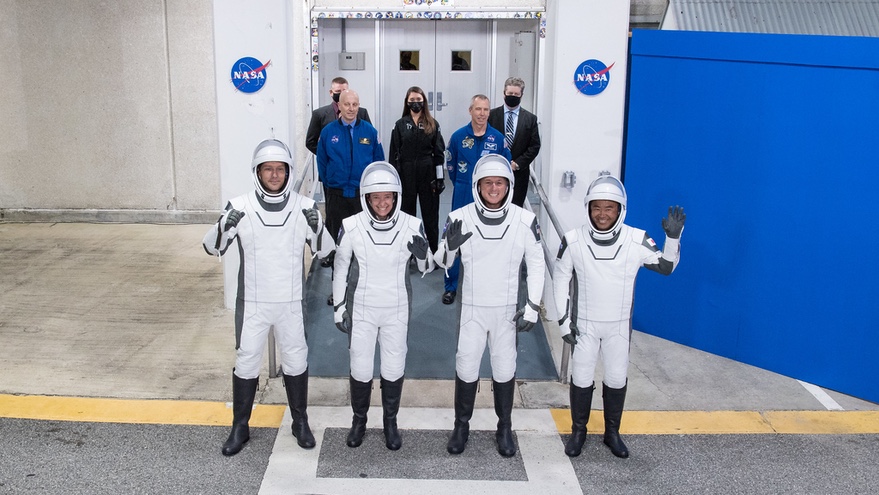KENNEDY SPACE CENTER, Fla. — SpaceX launched a Crew Dragon spacecraft carrying four astronauts from three nations April 23 as the commercial crew program moves firmly into operations.
The Falcon 9 rocket lifted off from Launch Complex 39A here at 5:49 a.m. Eastern on the Crew-2 mission. The Crew Dragon spacecraft separated from the Falcon 9 upper stage 12 minutes after liftoff, while the Falcon 9 first stage landed on a droneship in the Atlantic.
On board the Crew Dragon are NASA astronauts Shane Kimbrough and Megan McArthur, European Space Agency astronaut Thomas Pesquet and Japan Aerospace Exploration Agency astronaut. Akihiko Hoshide. Their spacecraft is scheduled to dock with the International Space Station at about 5:10 a.m. Eastern April 24.
The mission is the third crewed flight of the Crew Dragon in less than a year, after the Demo-2 mission in May 2020 and Crew-1 mission in November. The Crew-1 spacecraft is still at the ISS, and it will return with NASA astronauts Michael Hopkins, Victor Glover and Shannon Walker and JAXA astronaut Soichi Noguchi April 28.
Leading up to the launch, NASA officials said that, after a decade of development, the commercial crew program — or, at least, SpaceX’s vehicle in that program — had clearly moved into operations. “It’s very, very exciting to be in this operational cadence,” said Kathy Lueders, NASA associate administrator for human exploration and operations, during an April 15 press conference after the flight readiness review for the Crew-2 mission, which also reviewed plans to return Crew-1 to Earth.
Kimbrough, the commander of Crew-2, said this mission was the first to follow the streamlined training flow that future missions will use. “We’re the first ones to have gone through what we hope to be the templated flows for future crews,” he said at an April 17 press conference.
That revised training program, he said, combines training on the Crew Dragon spacecraft with that for the ISS. “It’s a little less than a year of training, where the crews in front of us had several years of training. Instead of being more developmental, it’s more operational now.”
“This has been a pretty amazing time with DM-2 and then the Crew-1 launch, and now we’re getting ready for Crew-2,” Bill Gerstenmaier, a former NASA associate administrator for human exploration and operations who is now a SpaceX vice president, said at the April 15 briefing.
He cautioned, though, that just because the commercial crew program is moving into a regular cadence of missions, it doesn’t mean crewed missions are routine. “We’re still beginning in this process. We need to not get lulled into thinking that this is fully operational and we’re ready to just continue this in an easy manner,” he said. “This is still very much a learning experience for us.”
That learning experience extends to this flight, which marks the first use of both a previously flown Falcon 9 first stage and Crew Dragon spacecraft on a crewed mission. “We had to do an extensive amount of work to look at both the Dragon for use and also the F9,” Steve Stich, NASA commercial crew program manager, said at that April 15 press conference.
That review both examined the vehicles to ensure they met requirements as well as make a number of upgrades to the Crew Dragon spacecraft based on the experience from the Demo-2 mission. Those changes included upgrades to the SuperDraco thrusters and other aspects of the propulsion system used for aborts and improving the spacecraft’s batteries.
“It was a series of upgrades to improve safety,” he said, “and having to make sure the structures, the component lifetimes were all within the certification and the qualification of those components.”
While the missions are becoming more operational, it is still early enough in the program for astronauts to develop new traditions. “Even though there’s some heritage from previous vehicles on the U.S. side, we still get to create some new traditions, which is really cool,” said Pesquet.
One thing the Crew-2 astronauts did that could become such a tradition, he said, is writing their initial in the soot on the Falcon 9 booster that will launch them. That soot is from the booster’s first launch, of the Crew-1 mission last November. “I don’t know if this is going to stick, but I found it really cool.”
The best tradition, though, may be a safe and successful flight. “My takeaway from where I sit right now is that we’ve just got to be really careful,” Gerstenmaier said. “We’re still learning. This is still just the beginning of how we move forward into this new commercial area.”
